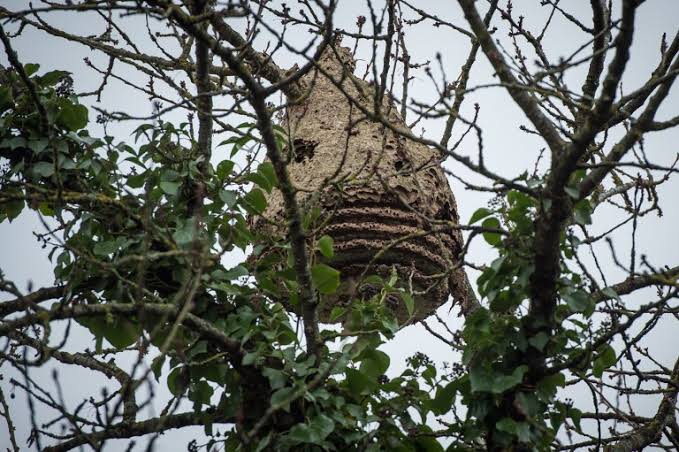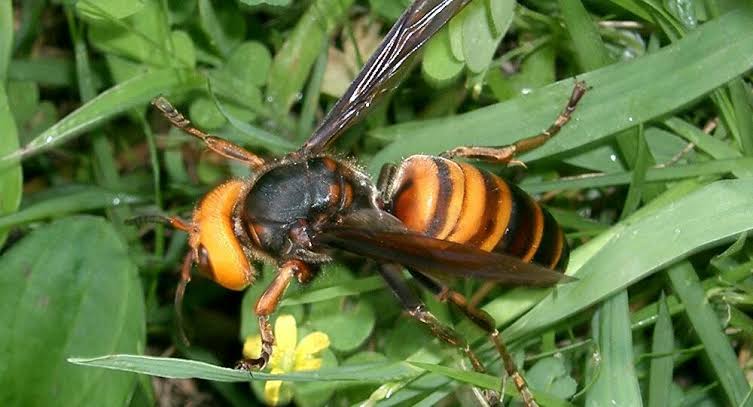Honeybee-Killing Giant ‘Murder Hornet’ Spotted In US For The First Time
Asian Giant Hornets also known as ‘Murder Hornets’ have been spotted for the first time in the United States, specifically in Washington, even as the world fights against Coronavirus, locust invasion and a possible Tsunami.
The first spotting of the 2-inch sized Asian giant hornet (vespa mandarinia) was verified in the United States by the Washington state Agriculture Department.
The giant hornet was first spotted in the state in December, and scientists believe it started becoming active again in April, when queens of the insects emerge from hibernation to build nests and form colonies.

Murder hornets, as it is nicknamed, have a peculiar appetite for bees and specialize in group attacks but generally does not target people.
However, they’re the world’s largest hornets with a sting that can kill humans if stung multiple times, experts at the Washington State University said.
Washington state Agriculture Department verified the spotting of the insect after beekeepers reported piles of dead bees with their heads ripped off, an alarming sight in a country with a rapidly declining bee population, CNN reports.
The slaughter of bees usually begin between late summer and the fall seasons when a worker hornet spots a colony, marks it with a pheromone and then brings a backup crew of between two and 50 others. While a honeybee hive can have thousands of residents, hornets can wipe out the whole population in hours.
Giant hornets of this species enters a “slaughter phase” during which they decapitate honeybees and destroy entire hives in the span of a few hours, according to the Washington state Agriculture Department.
Although the species was first spotted months ago, the term “murder hornet” circulated on Twitter over the weekend after a New York Times reported efforts being put in place to stop the species from annihilating honeybees.
Describing the hornets, Susan Cobey, a bee breeder at the department of entomology, Washington State University (WSU) recently said;
They’re like something out of a monster cartoon with this huge yellow-orange face.
Scientists don’t know how these giant hornets native to Asia ended up in Washington state, but it was gathered that they can sometimes be transported in international cargo, according to Seth Truscott of WSU‘s college of agricultural, human and natural resource sciences.
Truscott in the WSU’s Insider publication stressed that;
Hornets are most destructive in the late summer and early fall, when they are on the hunt for sources of protein to raise next year’s queens. They attack honey bee hives, killing adult bees and devouring bee larvae and pupae, while aggressively defending the occupied colony.
He revealed that their stings are big and painful, with a potent neurotoxin, adding that multiple stings can kill humans, even if they are not allergic.
In the bid to control invasion of the hornets, Washington state agricultural officials have asked beekeepers and residents to report any sightings of the giant hornets.
Entomologist Chris Looney of the state Department of Agriculture said;
Don’t get too close. Its sting can penetrate a regular beekeeper’s suit, and state scientists had to order special reinforced suits.
Don’t try to take them out yourself if you see them. If you get into them, run away, then call us! It is really important for us to know of every sighting, if we’re going to have any hope of eradication.
The officials have also asked residents of Whatcom, Skagit, Island, San Juan, Jefferson and Clallam counties to be vigilant.
State officials have set up traps and launched an app to quickly report sightings, saying just a few of the hornets can devastate a hive within hours.
Hornets risks decimating bees, which are already on endangered lists in the United States due to their sharply declining numbers.
And these bees pollinate plants producing fruit, nuts and vegetables which are crucial to the nation’s food supply.
Watch video below;

